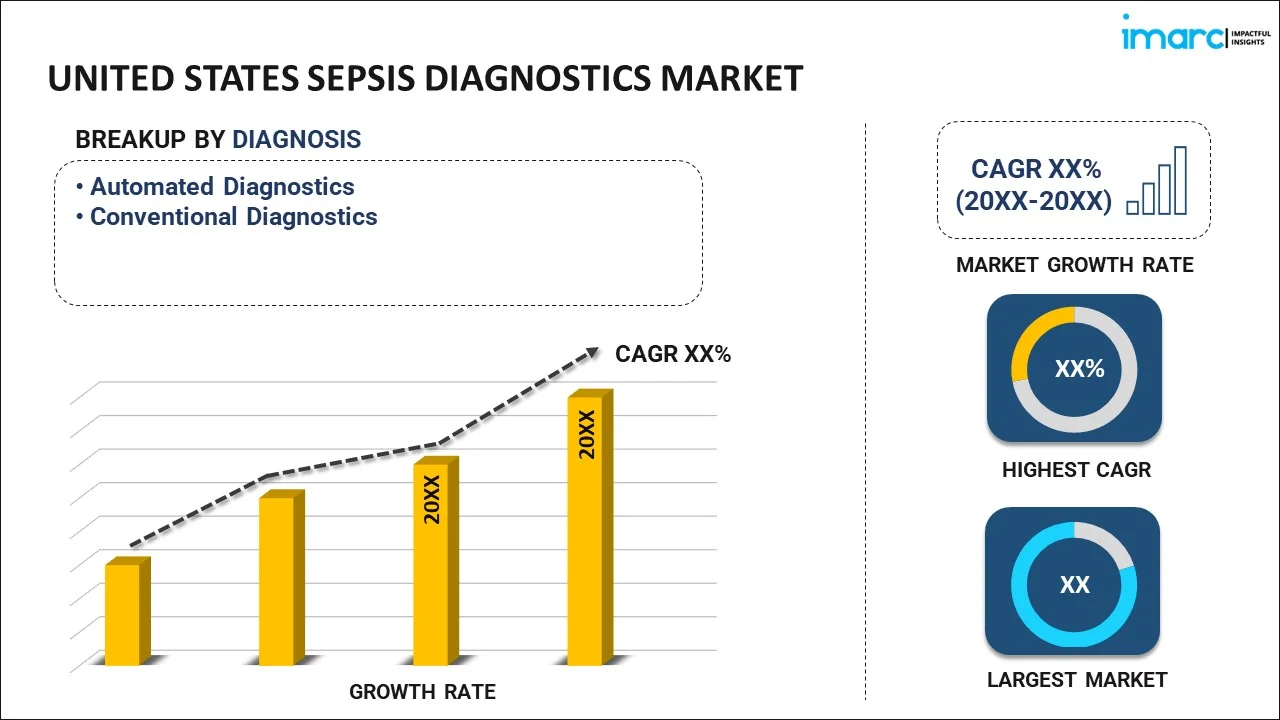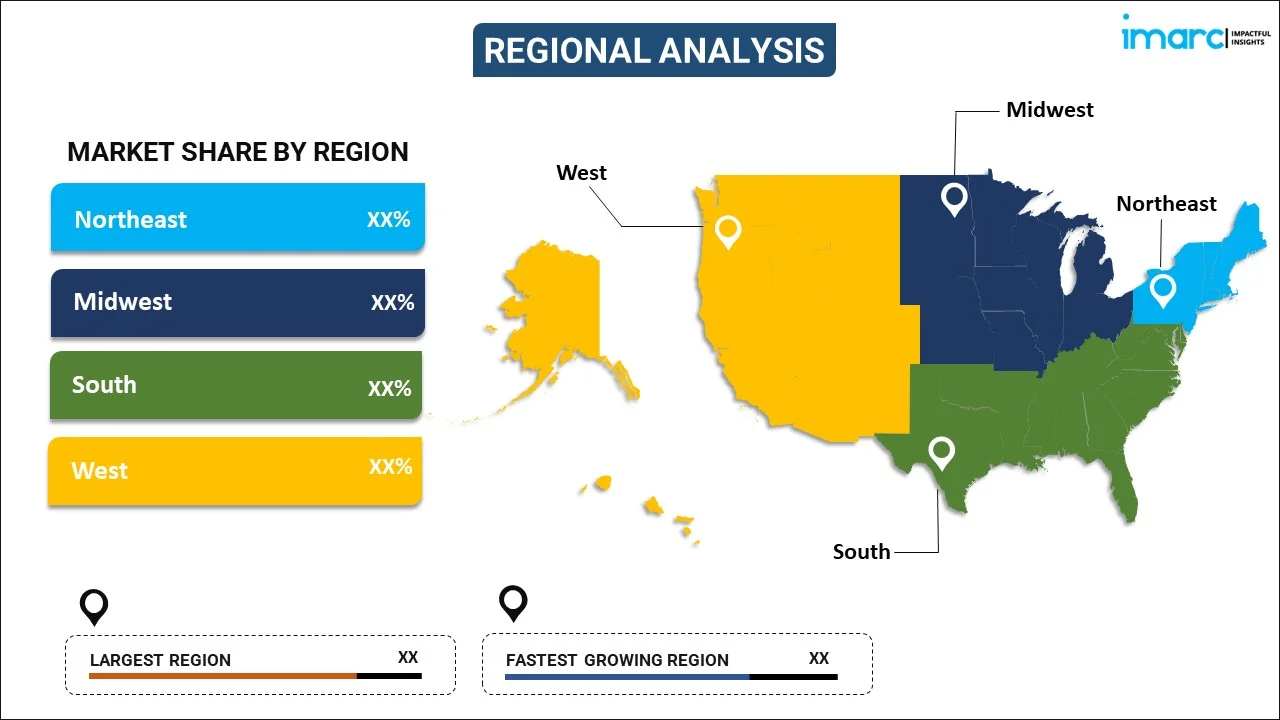
United States Sepsis Diagnostics Market Report by Diagnosis (Automated Diagnostics, Conventional Diagnostics), Product (Instruments, Assay Kits and Reagents, Blood Culture Media, Software), Mode of Testing (Laboratory Tests, Point-of-Care Tests), Technology (Molecular Diagnostics, Immunoassays, Biomarkers, Flow Cytometry, Microfluidics, Blood Culture), Pathogen (Bacterial Sepsis, Viral Sepsis, Fungal Sepsis, and Others), End User (Diagnostic Clinics, Hospitals, Research Laboratories), and Region 2025-2033
Market Overview:
The United States sepsis diagnostics market size reached USD 183.6 Million in 2024. Looking forward, IMARC Group expects the market to reach USD 354.5 Million by 2033, exhibiting a growth rate (CAGR) of 7.58% during 2025-2033. The increasing incidence of sepsis, the introduction of quality measures and reimbursement policies that incentivize healthcare facilities to implement sepsis protocols, and collaboration between healthcare institutions, research organizations, and diagnostic companies represent some of the key factors driving the market.
|
Report Attribute
|
Key Statistics
|
|---|---|
|
Base Year
|
2024 |
|
Forecast Years
|
2025-2033
|
|
Historical Years
|
2019-2024
|
| Market Size in 2024 | USD 183.6 Million |
| Market Forecast in 2033 | USD 354.5 Million |
| Market Growth Rate (2025-2033) | 7.58% |
Sepsis diagnostics refers to the process of identifying and diagnosing sepsis, a severe and life-threatening medical condition characterized by a systemic inflammatory response to infection. Sepsis can occur when the body's response to an infection becomes dysregulated, leading to widespread inflammation and potentially causing organ dysfunction or failure. Early and accurate diagnosis of sepsis is crucial for initiating prompt treatment and improving patient outcomes. Sepsis diagnostics typically involve a combination of clinical assessments, laboratory tests, and imaging studies to determine whether a patient has sepsis, the causative pathogen (bacteria, virus, or fungi), and the severity of the condition. Healthcare providers evaluate a patient's medical history and conduct a physical examination to look for signs and symptoms that may suggest sepsis. Common clinical indicators include fever or hypothermia, elevated heart rate (tachycardia), rapid breathing (tachypnea), low blood pressure (hypotension), altered mental state, and organ dysfunction. In recent years, there has been a growing emphasis on developing rapid and point-of-care sepsis diagnostic tests to expedite diagnosis and treatment initiation.
United States Sepsis Diagnostics Market Trends:
Sepsis is a major healthcare concern in the United States, with a significant number of cases occurring annually. The increasing incidence of sepsis drives the demand for accurate and timely diagnostic solutions to identify and treat the condition promptly. In addition, healthcare providers and institutions are increasingly recognizing the importance of early sepsis detection. Public awareness campaigns, educational initiatives, and clinical guidelines emphasize the need for early diagnosis and intervention, contributing to increased demand for sepsis diagnostics. Besides, regulatory bodies such as the Centers for Medicare & Medicaid Services (CMS) have introduced quality measures and reimbursement policies that incentivize healthcare facilities to implement sepsis protocols, including early diagnosis and treatment. Compliance with these guidelines fosters the adoption of sepsis diagnostics. Moreover, advances in diagnostic technologies, including molecular diagnostics, immunoassays, and biomarker discovery, have led to the development of more accurate and rapid sepsis diagnostic methods. New and innovative tests are continuously emerging, improving diagnostic capabilities and propelling the market. Additionally, the availability of point-of-care sepsis diagnostic tests allows for rapid testing at the bedside or in emergency departments. POCT enables faster decision-making and treatment initiation, reducing the time between diagnosis and intervention. Furthermore, the collaboration between healthcare institutions, research organizations, and diagnostic companies fosters innovation in sepsis diagnostics. Moreover, research efforts lead to the discovery of new biomarkers and diagnostic methods, which represents another major growth-inducing factor.
United States Sepsis Diagnostics Market Segmentation:
IMARC Group provides an analysis of the key trends in each segment of the market, along with forecasts at the country level for 2025-2033. Our report has categorized the market based on diagnosis, product, mode of testing, technology, pathogen, and end user.
Diagnosis Insights:

- Automated Diagnostics
- Conventional Diagnostics
The report has provided a detailed breakup and analysis of the market based on the diagnosis. This includes automated diagnostics and conventional diagnostics.
Product Insights:
- Instruments
- Assay Kits and Reagents
- Blood Culture Media
- Software
A detailed breakup and analysis of the market based on the product have also been provided in the report. This includes instruments, assay kits and reagents, blood culture media, and software.
Mode of Testing Insights:
- Laboratory Tests
- Point-of-Care Tests
The report has provided a detailed breakup and analysis of the market based on the mode of testing. This includes laboratory tests and point-of-care tests.
Technology Insights:
- Molecular Diagnostics
- Immunoassays
- Biomarkers
- Flow Cytometry
- Microfluidics
- Blood Culture
A detailed breakup and analysis of the market based on the technology have also been provided in the report. This includes molecular diagnostics, immunoassays, biomarkers, flow cytometry, microfluidics, and blood culture.
Pathogen Insights:
- Bacterial Sepsis
- Gram-Positive Bacterial Sepsis
- Gram-Negative Bacterial Sepsis
- Viral Sepsis
- Fungal Sepsis
- Others
The report has provided a detailed breakup and analysis of the market based on the pathogen. This includes bacterial sepsis (gram-positive bacterial sepsis and gram-negative bacterial sepsis), viral sepsis, fungal sepsis, and others.
End User Insights:
- Diagnostic Clinics
- Hospitals
- Research Laboratories
A detailed breakup and analysis of the market based on the end user have also been provided in the report. This includes diagnostic clinics, hospitals, and research laboratories.
Regional Insights:

- Northeast
- Midwest
- South
- West
The report has also provided a comprehensive analysis of all the major regional markets, which include Northeast, Midwest, South, and West.
Competitive Landscape:
The market research report has also provided a comprehensive analysis of the competitive landscape. Competitive analysis such as market structure, key player positioning, top winning strategies, competitive dashboard, and company evaluation quadrant has been covered in the report. Also, detailed profiles of all major companies have been provided.
United States Sepsis Diagnostics Market Report Coverage:
| Report Features | Details |
|---|---|
| Base Year of the Analysis | 2024 |
| Historical Period | 2019-2024 |
| Forecast Period | 2025-2033 |
| Units | Million USD |
| Scope of the Report | Exploration of Historical and Forecast Trends, Industry Catalysts and Challenges, Segment-Wise Historical and Predictive Market Assessment:
|
| Diagnosis Covered | Automated Diagnostics, Conventional Diagnostics |
| Products Covered | Instruments, Assay Kits and Reagents, Blood Culture Media, Software |
| Mode of Testings Covered | Laboratory Tests, Point-of-Care Tests |
| Technologies Covered | Molecular Diagnostics, Immunoassays, Biomarkers, Flow Cytometry, Microfluidics, Blood Culture |
| Pathogens Covered |
|
| End Users Covered | Diagnostic Clinics, Hospitals, Research Laboratories |
| Regions Covered | Northeast, Midwest, South, West |
| Customization Scope | 10% Free Customization |
| Post-Sale Analyst Support | 10-12 Weeks |
| Delivery Format | PDF and Excel through Email (We can also provide the editable version of the report in PPT/Word format on special request) |
Key Questions Answered in This Report:
- How has the United States sepsis diagnostics market performed so far and how will it perform in the coming years?
- What has been the impact of COVID-19 on the United States sepsis diagnostics market?
- What is the breakup of the United States sepsis diagnostics market on the basis of diagnosis?
- What is the breakup of the United States sepsis diagnostics market on the basis of product?
- What is the breakup of the United States sepsis diagnostics market on the basis of mode of testing?
- What is the breakup of the United States sepsis diagnostics market on the basis of technology?
- What is the breakup of the United States sepsis diagnostics market on the basis of pathogen?
- What is the breakup of the United States sepsis diagnostics market on the basis of end user?
- What are the various stages in the value chain of the United States sepsis diagnostics market?
- What are the key driving factors and challenges in the United States sepsis diagnostics?
- What is the structure of the United States sepsis diagnostics market and who are the key players?
- What is the degree of competition in the United States sepsis diagnostics market?
Key Benefits for Stakeholders:
- IMARC’s industry report offers a comprehensive quantitative analysis of various market segments, historical and current market trends, market forecasts, and dynamics of the United States sepsis diagnostics market from 2019-2033.
- The research report provides the latest information on the market drivers, challenges, and opportunities in the United States sepsis diagnostics market.
- Porter's five forces analysis assist stakeholders in assessing the impact of new entrants, competitive rivalry, supplier power, buyer power, and the threat of substitution. It helps stakeholders to analyze the level of competition within the United States sepsis diagnostics industry and its attractiveness.
- Competitive landscape allows stakeholders to understand their competitive environment and provides an insight into the current positions of key players in the market.
Need more help?
- Speak to our experienced analysts for insights on the current market scenarios.
- Include additional segments and countries to customize the report as per your requirement.
- Gain an unparalleled competitive advantage in your domain by understanding how to utilize the report and positively impacting your operations and revenue.
- For further assistance, please connect with our analysts.
 Request Customization
Request Customization
 Speak to an Analyst
Speak to an Analyst
 Request Brochure
Request Brochure
 Inquire Before Buying
Inquire Before Buying




.webp)




.webp)












